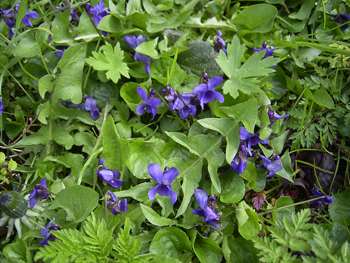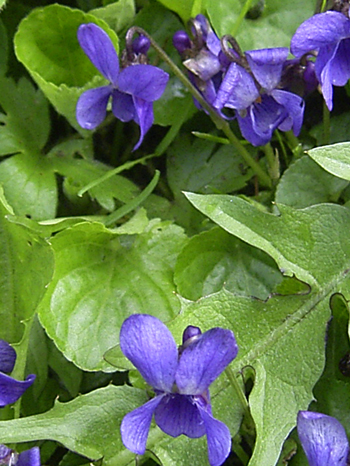Contents:
Common Names | Parts Usually Used | Plant(s) & Culture | Where Found | Medicinal Properties | Biochemical Information
Legends, Myths and Stories | Uses | Formulas or Dosages | Nutrient Content | Warning | Bibliography
Scientific Names

- Viola odorata L.
- Violaceae
- Violet family
Common Names
- Common blue violet
- Garden violet
- Hu-chin-ts’ao (Chinese name)
Parts Usually Used
Dried leaves and flowers; fresh rootstock
Back to Top

Description of Plant(s) and Culture
Garden violet is a small, European, perennial plant; the creeping rootstock sends out runners along the ground which also take root. The leaves are basal, petioled, and cordate. The spurred, violet, sometimes white or rose-colored, flowers grow on long peduncles, pale violet spurs at the back; from March to May. Fruits are rounded, hairy, three-part capsules.
Back to Top
Where Found
Commonly cultivated and also grows wild in damp woods, shady places, meadows, thickets, hedges, and along roadsides and the edges of woods. Native to Europe.
Back to Top
Medicinal Properties
Diaphoretic, emetic, expectorant, laxative, mucilaginous, antipyretic, alterative, antiseptic, anti-tumor, anti-inflammatory
Back to Top
Biochemical Information
Salicylic acid, volatile oil, mucilage, resin, sugar, an aromatic principle, flavonoids, a glucoside, saponins, an alkaloid called odoratine, rich in vitamins A and C. The flower also contains an aromatic compound called irone, and a blue pigment.
Back to Top
Legends, Myths and Stories
The violets have a large family tree; some 400 species, mostly perennial but a few annual herbs.
According to Greek legend, the violet originated from the tears of Io, a beautiful nymph whom Zeus loved. To hide Io from Hera, his jealous wife, Zeus changed her into a white heifer. When Io cried because the field grasses were coarse and bitter for her taste, Zeus transformed her tears into violets to provide her a more delicate food. In Greek burials it was the custom to cover the dead person with violets as a symbol of both the beauty and the transitory quality of life.
As far back as 500 BC, violet herbs were used in poultice form as a cure for surface cancer (skin cancer). Homer relates how the Athenians used violets to moderate anger. Pliny recommended wearing a garland of violets to prevent headaches and dizziness.
Because of his fondness for the flower, Napoleon was sometimes known as Corporal Violet. When he was exiled on Elba, the violet became his symbol for his supporters. Violets were strewn along the parade route when he returned to power in Paris, after escaping from the island.
Back to Top
Uses
Garden violet is primarily an herb for respiratory problems. A tea made from the leaves is excellent as a soothing gargle, for sore gums, canker sores, good for inflammations, relieves pain of cancerous growths, as well as used as a poultice to the back of the neck for headache. A blood purifier, good for treating gout, colds, asthma, sores, ulcers, scrofula, pleurisy, syphilis, and difficult breathing due to gas and morbid matter in the stomach and bowels. The flowers lower blood pressure. Has been used to treat blemished skin, psoriasis, eczema, acne, and infants’ cradle cap. A decoction of the rootstock makes a good expectorant. For inflamed mucous tissue in the mouth, rinse with a tea made from the rootstock or the whole plant. A tea or syrup made from the plant, especially the rootstock and the flowers, is a soothing remedy for coughs and whooping cough. Use it also as a calming agent for insomnia and hysterical or nervous problems. The flowers and the seeds can be used as a mild laxative. In large doses, the rootstock is emetic. Particularly used to soften hard lumps and counteract cancer, swollen glands.
Violet leaves are used in puddings, jellies, and salads; flowers in salads or in candied form as a decorative garnish for desserts.
Back to Top
Formulas or Dosages
Collect the rootstock in the fall.
Infusion: steep 1 tsp. mixed plant parts in 1/2 cup water and strain.
Decoction: boil 1 tbsp. rootstock or plant parts in 1/2 cup water. Soaking for a few hours before boiling is said to strengthen the activity.
Syrup: pour 1 qt. boiling water over an equal volume of compressed flowers; let stand for 10 hours and strain. Heat the resulting liquid to simmering and pour over a new batch of flowers. Let stand and strain as before. Repeat the procedure several more times (the more the better). Heat the final liquid, let cool, and add honey until a syrupy consistency is obtained.
Back to Top
Nutrient Content
Rich in vitamins A and C.
Back to Top
Warning
Avoid very high doses, as they contain saponins, which may induce nausea and vomiting.
Back to Top
Bibliography
![]() Back to Eden
Back to Eden, by Jethro Kloss; Back to Eden Publishing Co., Loma Linda, CA 92354, Original copyright 1939, revised edition 1994
![]() The Herb Book
The Herb Book, by John Lust, Bantam Books, 666 Fifth Avenue, New York, NY. copyright 1974.
![]() The Complete Medicinal Herbal
The Complete Medicinal Herbal, by Penelope Ody, Dorling Kindersley, Inc, 232 Madison Avenue, New York, NY 10016, First American Edition, copyright 1993
![]() Eastern/Central Medicinal Plants
Eastern/Central Medicinal Plants, by Steven Foster and James A. Duke., Houghton Mifflin Company, 215 Park Avenue South, New York, NY 10000
Herbal Gardening, compiled by The Robison York State Herb Garden, Cornell Plantations, Matthaei Botanical Gardens of the University of Michigan, University of California Botanical Garden, Berkeley., Pantheon Books, Knopf Publishing Group, New York, 1994, first edition
 The Magic of Herbs
The Magic of Herbs, by David Conway, published by Jonathan Cape, Thirty Bedford Square, London, England. (Out of print)
![]() Culpeper’s Complete Herbal & English Physician: Updated With 117 Modern Herbs
Culpeper’s Complete Herbal & English Physician: Updated With 117 Modern Herbs, by Nicholas Culpeper, Meyerbooks, publisher, PO Box 427, Glenwood, Illinois 60425, 1990, (reprint of 1814)
![]() Planetary Herbology
Planetary Herbology, by Michael Tierra, C.A., N.D., O.M.D., Lotus Press, PO Box 325, Twin Lakes. WI 53181., Copyright 1988, published 1992
![]() Indian Herbalogy of North America
Indian Herbalogy of North America, by Alma R. Hutchens, Shambala Publications, Inc., Horticultural Hall, 300 Massachusetts Avenue, Boston, Massachusetts 02115, 1973
![]() American Folk Medicine
American Folk Medicine, by Clarence Meyer, Meyerbooks, publisher, PO Box 427, Glenwood, Illinois 60425, 1973
![]() Webster’s New World Dictionary
Webster’s New World Dictionary, Third College Edition, Victoria Neufeldt, Editor in Chief, New World Dictionaries: A Division of Simon & Schuster, Inc., 15 Columbus Circle, New York, NY 10023
 An Instant Guide to Medicinal Plants
An Instant Guide to Medicinal Plants, by Pamela Forey and Ruth Lindsay, Crescent Books (January 27, 1992).
 Secrets of the Chinese Herbalists
Secrets of the Chinese Herbalists, by Richard Lucas, Parker Publishing Company, Inc., West Nyack, NY, 1987.
![]() The Yoga of Herbs: An Ayurvedic Guide to Herbal Medicine
The Yoga of Herbs: An Ayurvedic Guide to Herbal Medicine, by Dr. David Frawley & Dr. Vasant Lad, Lotus Press, Twin Lakes, Wisconsin, Second edition, 1988.
 The Rodale Herb Book: How to Use, Grow, and Buy Nature’s Miracle Plants (An Organic gardening and farming book)
The Rodale Herb Book: How to Use, Grow, and Buy Nature’s Miracle Plants (An Organic gardening and farming book), edited by William H. Hylton, Rodale Press, Inc. Emmaus, PA, 18049., 1974
![]() Country Home Book of Herbs
Country Home Book of Herbs, Meredith Books, Editorial Dept. RW240, 1716 Locust Street, Des Moines, IA 50309-3023, copyright 1994
 The Healing Plants
The Healing Plants, by Mannfried Pahlow, Barron’s Educational Series, Inc. 250 Wireless Blvd., Hauppauge, NY 11788, 1992
